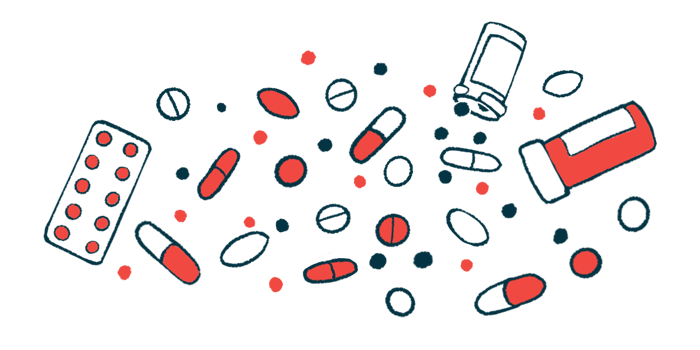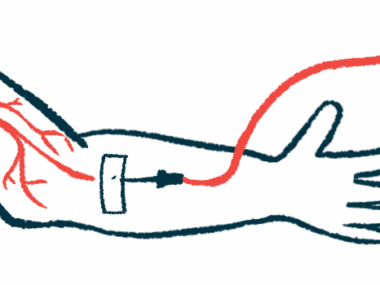Cyclophosphamide Plus Rituximab Prevents AAV Relapses: Study
Use of the combination offers most benefits in first two years
Written by |

Adding a low dose of cyclophosphamide to rituximab for remission induction was safe and more effective at preventing relapses in the first two years in people with severe ANCA-associated vasculitis (AAV) than rituximab alone, a new study shows.
No significant benefit was observed in the combination treatment after five years.
These findings suggest the combo therapy “might have a beneficial effect on the prevention of major relapses, without increasing the risk of adverse events,” the researchers wrote.
The study, “Adding low dose cyclophosphamide to rituximab for remission-induction may prolong relapse-free survival in patients with ANCA vasculitis: A retrospective study,” was published in The Journal of Translational Autoimmunity.
AAV comprises a group of diseases in which self-reactive antibodies mistakenly target proteins in neutrophils, a type of immune cell. This abnormal immune attack activates neutrophils, and they start attacking the cells lining small and medium blood vessels, causing inflammation. This can lead to life-threatening organ damage.
Standard AAV treatment consists mainly of immunosuppressive therapies. Remission-induction treatment with “cyclophosphamide (CYC) and rituximab (RTX), either separately or combined, in combination with glucocorticosteroids (GCS), have proven to be effective in patients with AAV,” the researchers wrote.
Rituximab is sold as Rituxan in the U.S., MabThera in Europe, and is available as biosimilars.
While no adequately controlled trial has compared the safety and efficacy of rituximab alone with those of rituximab plus low-dose cyclophosphamide in AAV patients, “the major relapse risk appears to be lower when CYC is added to RTX,” the researchers wrote.
This suggests combining these therapies may be particularly beneficial to AAV patients with severe organ involvement to prevent further tissue damage.
Safety, efficacy of combo, rituximab alone examined
Now, a team of researchers in the Netherlands retrospectively analyzed safety and efficacy data of AAV patients treated with either rituximab plus low-dose cyclophosphamide or rituximab alone as remission-induction treatment.
The analysis included 62 patients treated at the Maastricht University Medical Centre between March 2007 and January 2019. In total, 34 patients (median age 63, 17 men) received the combo treatment and 28 patients (median age 60, 19 men) received rituximab alone (monotherapy) as remission-induction therapy.
Rituximab treatment consisted of two doses of 1,000 mg within two weeks, while cyclophosphamide was given as two doses of 15 mg per kilogram within two weeks.
All patients were also given glucocorticoids — methylprednisolone, delivered into-the-vein, or oral prednisolone — with induction therapy, and received an individualized regimen of rituximab as maintenance therapy.
All patients were followed for at least two years, with a median follow-up of four years.
At the start of the analysis (baseline) both groups showed similar age, sex, disease activity, and relapse rates. However, kidney involvement was significantly more prevalent in the combo therapy group when compared to the monotherapy group (85% vs. 61%).
Seven patients in the combo therapy group who had severe kidney disease and/or lung bleeding required additional plasma exchange therapy. Also called plasmapheresis, this procedure involves replacing a person’s plasma — the noncellular parts of blood.
Follow-ups at two and five years after treatment
The researchers analyzed the frequency of major relapses and the safety profile at two and five years after induction therapy. A major relapse was when symptoms of major organ involvement, according to the Birmingham Vasculitis Activity Score, returned and patients required remission-induction therapy.
Results showed disease remission was maintained for three months in 17 patients (50%) in the combo therapy group, with 91% still in remission after 12 months. In the rituximab alone group, three-month remission was achieved by 21 patients (75%), and 12-month remission by 25 patients (89%).
Within the first two years after induction therapy, major relapses occurred in one patient (3%) in the combo therapy group and in six patients (24%) in the monotherapy group. This represented an 81% lower risk of major relapse for patients given rituximab plus cyclophosphamide compared with those receiving rituximab alone.
In total, 14 patients experienced major relapses within five years: seven (20.6%) in the combo group and other seven (25%) in the monotherapy group. No significant group differences were observed for relapse risk.
Kidney relapses occurred in three of the six patients in the combo therapy group who showed kidney involvement at the start of the analysis and in one of the two with kidney involvement in the monotherapy group.
No significant differences were seen between groups at two and five years of remission in the rate of infections, end-stage kidney disease, or cancer. Also, no differences were seen for hypogammaglobulinemia, a condition characterized by low levels of antibodies made by white blood cells to fight infection.
During the two-year follow-up, six patients died, five of whom (83%) were given the combo therapy. Two additional patients had died by the fifth year: one in each group. No statistically significant group differences were seen in mortality rates at either time point.
“Two years after remission-induction therapy, we observed [significantly] more relapses in patients treated with RTX only,” the researchers wrote, but “this difference disappeared after five years of follow-up.”
“There was no significant difference in the occurrence of adverse events,” they wrote.
Overall, these findings highlight that rituximab plus low-dose cyclophosphamide is “safe and may prevent major relapses in patients with severe AAV in the first two years after remission-induction [therapy],” the researchers wrote.
“The results may support clinical decision making and contribute to future research,” the team wrote, adding that adequately-controlled trials that “compare the efficacy and safety between RTX and a combination of RTX with CYC are needed.”






